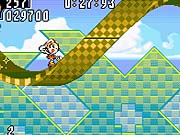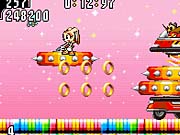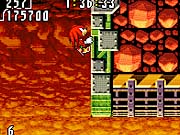Although Sega found tremendous success with the first Sonic Advance--it sold more than 500,000 copies--the game itself didn't stray much from the design established in Sonic the Hedgehog 2, which appeared on the Sega Genesis console more than a decade ago. Even the graphics, as colorful and speedy as they were, neglected to use any of the special effects made possible by the GBA hardware. Practically speaking, Sonic Advance was a low-risk method of bringing the series back to its 2D roots and reintroducing the Sonic character to the massive audience that sidestepped the Sonic Adventure games on the Dreamcast console. Sonic Advance 2 is a different story. The levels are larger and require more exploration than the typical Sonic game; the abilities of the five separate playable characters actually have an influence over the strategy you'll use to complete an area; and the graphics are more in line with what you've come to expect out of the Game Boy Advance.


In the past, the reward for gathering all the chaos emeralds was the ability to play as a supercharged Sonic or to face the true form of the last boss. In Sonic Advance 2, they're literally the key to getting the most out of the game. From the outset, you can access the main game, which has seven zones and 15 levels, as well as a time attack mode and two multiplayer race modes. In order to unlock the sound test and boss time-attack features, as well as a fifth playable character and an extra final level, you have to gather all of the chaos emeralds and beat the game with multiple characters. The game also includes an updated version of the Tiny Chao Garden virtual pet that came with the first Sonic Advance. There are more varieties of chao characters that you can raise, and you can interact with them by giving them toys purchased with the rings collected in the main game. You also have the option of transferring your chao animals into the GameCube version of Sonic Adventure 2: Battle using the GBA-GameCube link cable. Like with the other bonus features, you have to collect all of the chaos emeralds before Tiny Chao Garden is made available. This is no easy feat to accomplish, and most players will have to content themselves with the standard modes that are available from the beginning.
Sonic Advance 2 is easily the toughest 2D Sonic game ever made, and not just because the special rings and chaos emeralds are difficult to collect. The boss battles against Robotnik's inventions are positively cutthroat. Unlike previous Sonic games, where the action would come to a standstill and you'd fight Robotnik in a confined area, the battles in Sonic Advance 2 occur while you're on the run. In order to attack the weak spot on each of Robotnik's machines, you first need to catch up to it, taking care not to get hit by the missiles or spikes tumbling out of the thing. Every time you hit the weak spot, you're knocked back and have to repeat the process again. It isn't an exaggeration to suggest that you'll see the game-over screen a few times before you master the pattern of each boss. At the end of the game, you have to fight them all over again, one after another, in order to reach Robotnik's final invention. Sonic Advance 2 is a difficult game to beat, even if you don't care about unlocking the extras.

Even though most of the enhancements in Sonic Advance 2 make the game more difficult, they also make it much more interesting than previous Sonic games. In each level, you actually get the sense that you're exploring an area with a variety of features and landmarks. You figure out which characters can access spots the others can't. You come to learn where the enemies are, where the power-ups are, where the special rings are, and which tunnels and loops you can access to get through the level faster without bypassing the items you need to collect. Like any good Sonic game, there are still plenty of opportunities to put the pedal to the metal and trigger a chain reaction of turbo ramps, bumpers, and corkscrews.
Fans of the previous Sonic Advance are most likely to be impressed by the visual aspects of Sonic Advance 2. Graphically, it's a more ambitious and detailed game that makes use of the many effects afforded by the GBA hardware. Clouds in the distance scroll by as you run along; searchlights sway back and forth in a couple of backgrounds; and subtle clouds of leaves and snow blow past in levels where they're appropriate. One area, the techno base zone, has terrain composed entirely of lasers and psychedelic flashing lights. The character animation is much better this time around as well. They each bend and strain like exaggerated cartoon animals while charging up their dash attacks and make odd facial expressions whenever they stumble into enemies. Each character has multiple sprite sequences for running, jumping, and dashing, as well as specific actions for various situations involving interactions with enemies and objects.

Sega took a risk by making Sonic Advance 2 so large and so challenging. It pays off, however, since all of the changes and improvements combine to form the first truly original 2D Sonic game since Sonic the Hedgehog 2 landed way back in 1992. It will take you a long time to learn how to play this new Sonic, and you'll absolutely come to despise some of the bosses, but in the end you'll come away satisfied.



